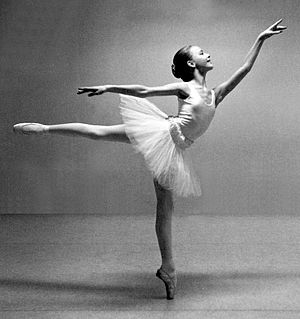 W
WArabesque in dance, particularly ballet, is a body position in which a dancer stands on one leg–the supporting leg–with the other leg–the working leg–turned out and extended behind the body, with both legs held straight.
 W
WBallon is the appearance of being lightweight and light-footed while jumping. It is a desirable aesthetic in ballet and other dance genres, making it seem as though a dancer effortlessly becomes airborne, floats in the air, and lands softly. The name is widely thought to be derived from the French word ballon, though it has been dubiously claimed that the name was inspired by French ballet danseur Claude Balon, who was known for performing exceptionally light leaps.
 W
WA barre is a stationary handrail that provides support for people during various types of exercise. Barres are used extensively in ballet training and warm up exercises, where such exercises are commonly referred to as barre work. In a ballet class, barre may also refer to the part of the class that involves barre work. Barres are also used for warm up exercises in other types of dance, as well as in general fitness programs.
 W
WIn ballet, battement is an alternating side-to-side movement of the working (non-supporting) leg. Battements are typically performed in multiples, quickly and in rapid succession so that the working foot appears to be fluttering or vibrating. They are usually executed in front, to the side or in back. The word battement is of French origin, meaning "beat".
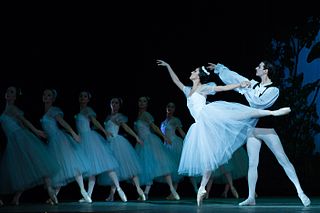 W
WA ballet blanc is a scene in which the ballerina and the female corps de ballet all wear white dresses or tutus. Typical in the Romantic style of ballet from the nineteenth century, ballets blancs are usually populated by ghosts, dryads, naiads, enchanted maidens, fairies, and other supernatural creatures and spirits.
 W
WThe bourrée is a dance of French origin and the words and music that accompany it. The bourrée resembles the gavotte in that it is in double time and often has a dactylic rhythm. However, it is somewhat quicker, and its phrase starts with a quarter-bar anacrusis or "pick-up", whereas a gavotte has a half-bar anacrusis.
 W
WIn dance and gymnastics, a turn is a rotation of the body about the vertical axis. It is usually a complete rotation of the body, although quarter (90°) and half (180°) turns are possible for some types of turns. Multiple, consecutive turns are typically named according to the number of 360° rotations.
 W
WThe chassé is a dance step used in many dances in many variations. All variations are triple-step patterns of gliding character in a "step-together-step" pattern. The word came from ballet terminology.
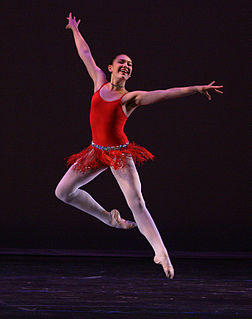 W
WContemporary ballet is a genre of dance that incorporates elements of classical ballet and modern dance. It employs classical ballet technique and in many cases classical pointe technique as well, but allows greater range of movement of the upper body and is not constrained to the rigorously defined body lines and forms found in traditional, classical ballet. Many of its attributes come from the ideas and innovations of 20th-century modern dance, including floor work and turn-in of the legs. The style also contains many movements emphasizing the bodies flexibility.
 W
WIn ballet, the corps de ballet is the group of dancers who are not principal dancers or soloists. They are a permanent part of the ballet company and often work as a backdrop for the principal dancers.
 W
WIn dance and gymnastics, a turn is a rotation of the body about the vertical axis. It is usually a complete rotation of the body, although quarter (90°) and half (180°) turns are possible for some types of turns. Multiple, consecutive turns are typically named according to the number of 360° rotations.
 W
WIn dance and gymnastics, a turn is a rotation of the body about the vertical axis. It is usually a complete rotation of the body, although quarter (90°) and half (180°) turns are possible for some types of turns. Multiple, consecutive turns are typically named according to the number of 360° rotations.
 W
WIn ballet, a grand pas is a suite of dances that serves as a showpiece for lead dancers, demi-soloists, and in some cases the corps de ballet. It usually consists of an entrée (introduction), a grand adage, sometimes a dance for the corps de ballet, optional variations for the demi-soloists, variations for the lead ballerina or danseur or both, and a coda, which concludes the suite.
 W
WA narrative ballet or story ballet is a form of ballet that has a plot and characters. It is typically a production with full sets and costumes. It was an invention of the eighteenth century.
 W
WNeoclassical ballet is the style of 20th-century classical ballet exemplified by the works of George Balanchine. The term "neoclassical ballet" appears in the 1920s with Sergei Diaghilev's Ballets Russes, in response to the excesses of romanticism and post-romantic modernism. It draws on the advanced technique of 19th-century Russian Imperial dance, but strips it of its detailed narrative and heavy theatrical setting while retaining many key techniques, such as pointe technique.
 W
WIn ballet, a pas de deux [pɑ d(ə) dø] is a dance duet in which two dancers, typically a male and a female, perform ballet steps together. The pas de deux is characteristic of classical ballet and can be found in many well-known ballets, including Sleeping Beauty, Swan Lake, and Giselle. It is most often performed by a male and a female though there are exceptions, such as in the film White Nights, in which a pas de deux is performed by Mikhail Baryshnikov and Gregory Hines.
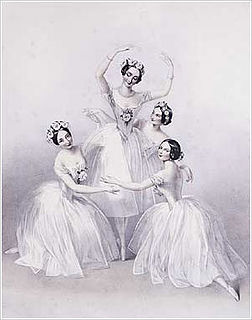 W
WPas de quatre is a French term used to identify a ballet dance for four people. Pas de quatre are usually plotless dances performed as divertissements within the context of a larger work. However, narrative pas de quatre and pas de quatre that stand alone are not unknown.
 W
WIn ballet, pas de trois [pɑ də tʁwɑ] is a French term usually referring to a dance between three people. Typically, a pas de trois in ballet consists of five parts:Entrée Variation for the 1st dancer Variation for the 2nd dancer Variation for the 3rd dancer Coda
 W
WIn dance and gymnastics, a turn is a rotation of the body about the vertical axis. It is usually a complete rotation of the body, although quarter (90°) and half (180°) turns are possible for some types of turns. Multiple, consecutive turns are typically named according to the number of 360° rotations.
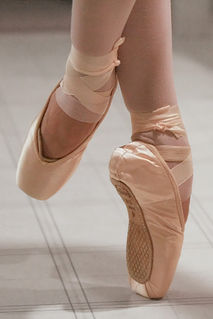 W
WA pointe shoe is a type of shoe worn by ballet dancers when performing pointe work. Pointe shoes were conceived in response to the desire for dancers to appear weightless and sylph-like and have evolved to enable dancers to dance en pointe for extended periods of time. They are manufactured in a variety of colors, most commonly in shades of light pink.
 W
WPointe technique is the part of classical ballet technique that concerns pointe work, in which a ballet dancer supports all body weight on the tips of fully extended feet within pointe shoes. A dancer is said to be en pointe when the dancer's body is supported in this manner, and a fully extended vertical foot is said to be en pointe when touching the floor, even when not bearing weight. Pointe work is performed while wearing pointe shoes, which employ structural reinforcing to distribute the dancer's weight load throughout the foot, thus reducing the load on the toes enough to enable the dancer to support all body weight on fully vertical feet.
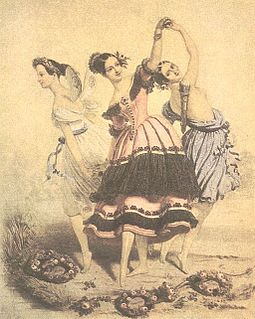 W
WThe Romantic ballet is defined primarily by an era in ballet in which the ideas of Romanticism in art and literature influenced the creation of ballets. The era occurred during the early to mid 19th century primarily at the Théâtre de l'Académie Royale de Musique of the Paris Opera Ballet and Her Majesty's Theatre in London. It is typically considered to have begun with the 1827 début in Paris of the ballerina Marie Taglioni in the ballet La Sylphide, and to have reached its zenith with the premiere of the divertissement Pas de Quatre staged by the Ballet Master Jules Perrot in London in 1845. The Romantic ballet had no immediate end, but rather a slow decline. Arthur Saint-Léon's 1870 ballet Coppélia is considered to be the last work of the Romantic Ballet.
 W
WIn ballet, turnout is rotation of the leg at the hips which causes the feet to turn outward, away from the front of the body. This rotation allows for greater extension of the leg, especially when raising it to the side and rear. Turnout is an essential part of classical ballet technique.
 W
WThe tutu is a dress worn as a costume in a classical ballet performance, often with attached bodice. It may be made of tarlatan, muslin, silk, tulle, gauze, or nylon. Modern tutus have two basic types: the Romantic tutu is soft and bell-shaped, reaching the calf or ankle; the Classical tutu is short and stiff, projecting horizontally from the waist and hip.
 W
WIn ballet, a variation is a solo dance. In a classical grand pas de deux, the ballerina and danseur each perform a variation.